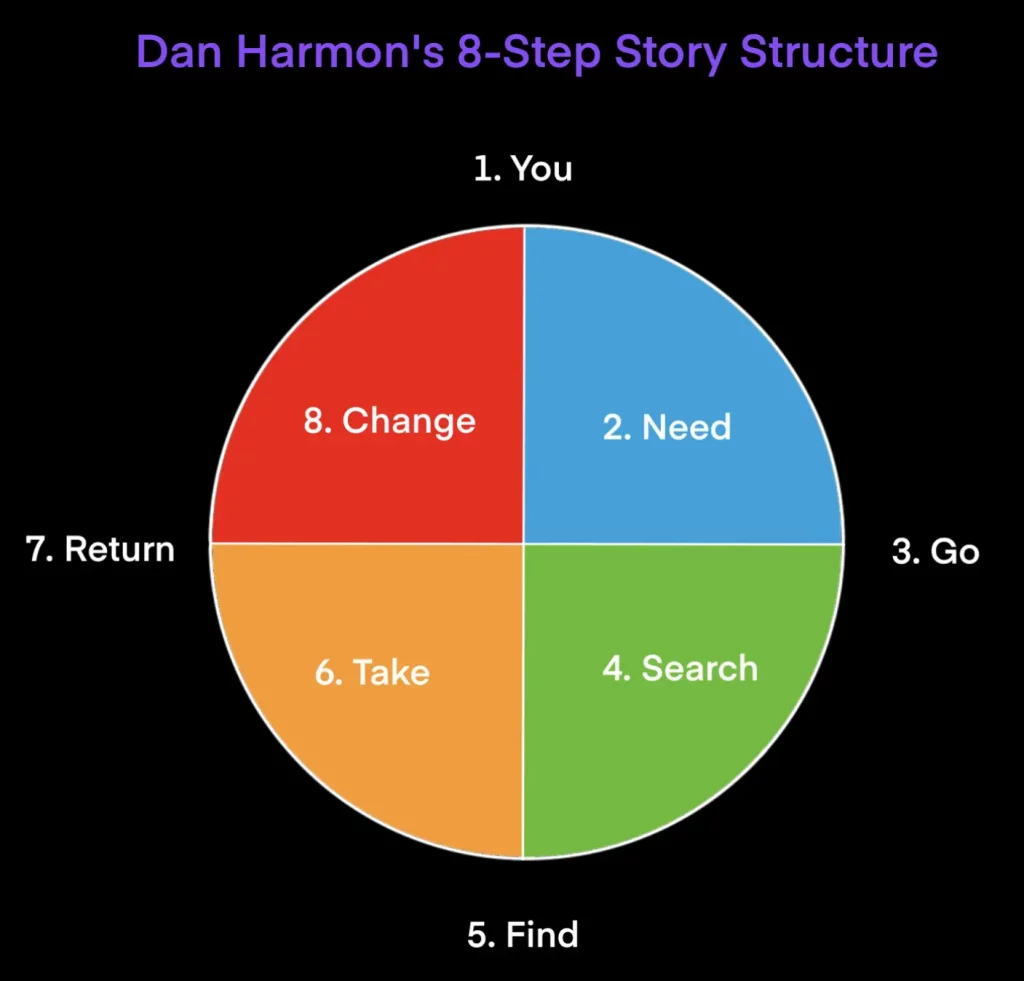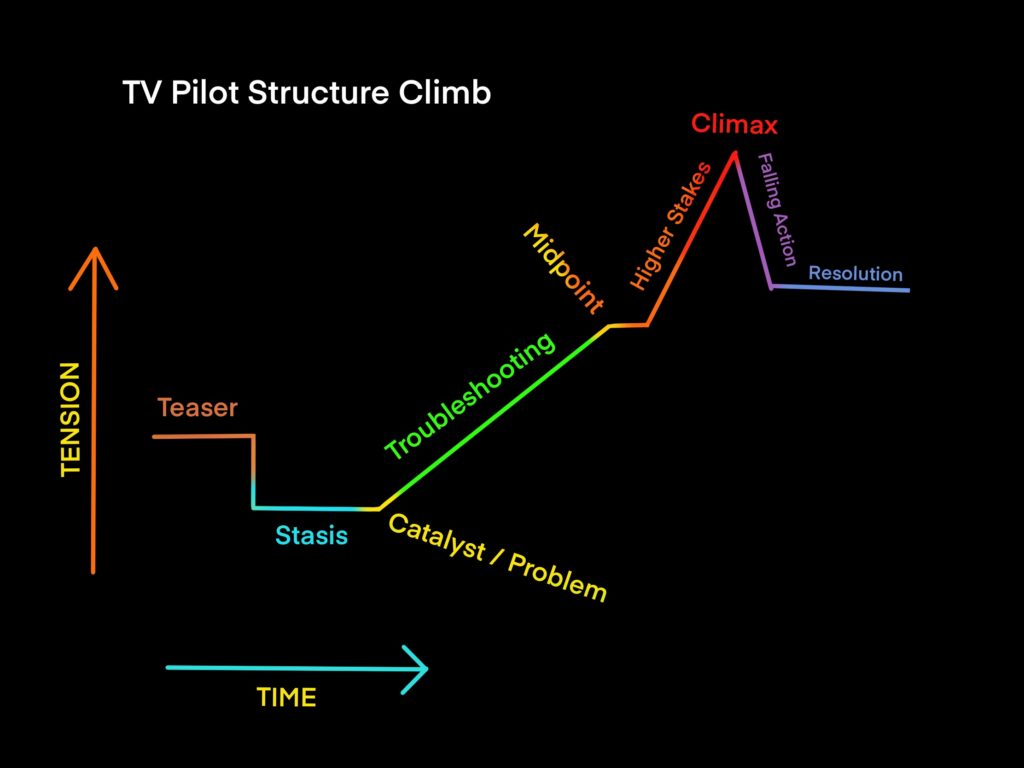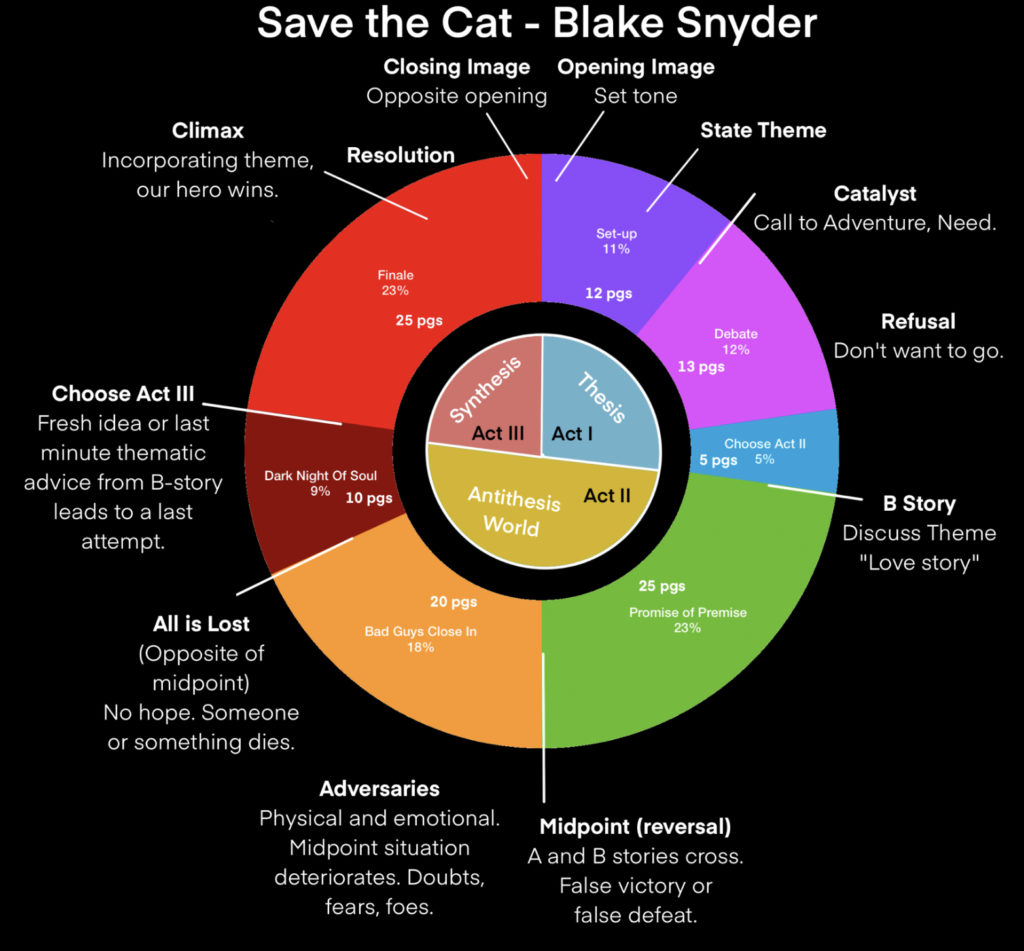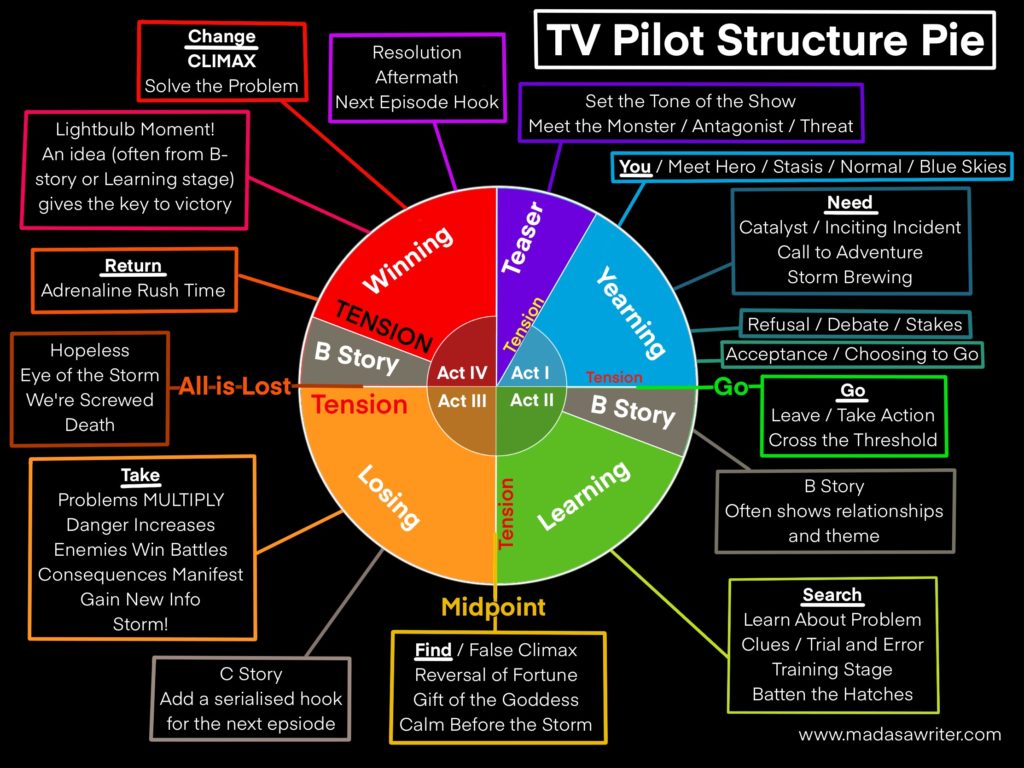Story Structure BASICS
Story Structure - More than a Beginning, Middle, and End!
Let's talk about the nuts and bolts of story structure. There's an inherent rhythm to stories that goes beyond, "I was doing X when Y happened and I Z'ed!" Don't believe me? Let me start by recounting the true story of my dad and the bat:
Dad ate a peanut butter sandwich. Washed up. Later, he saw a bat, tried to get it down, and it flew away.
Pretty terrible story right? That's because we instinctively know a good story needs certain parts. In this case who cares about the sandwich? We want to focus on the exciting stuff - the bat! CUT TO THE CHASE!
Okay, what about: Dad fell off a ladder onto a chair and then a bat flew outside.
Happy now? No. We cut to the chase (he fell!), but we want to know WHY. The important part (the NEED) - that Dad was trying to get the bat out at the time - is missing, so the two events seem unrelated.
Here's how it really went down:
Dad saw a bat flying around the living room. It settled in the top corner of the room by the ceiling, so he put gloves on, got the ladder, and climbed up. He balanced near the top step... reached out slowly to grab the bat... The bat flew right in his face! He reared back, toppled off the ladder and yelled, "I'm coming down!" He landed on an Ikea chair - miraculously unhurt - and the bat flew out the open door on its own.
Now that's a story! And one poor Dad will never live down. That has STRUCTURE. TENSION. STAKES. IRONY. So let's take a deeper dive into the theories behind the structure.
History of Story Structure
People have been writing about structure since Aristotle wrote Poetics in the 4th century BC. More recently Joseph Campbell, Syd Field, and Blake Snyder took a crack at it. If you've never analysed structure and/or you want to dive deep, check out the Resources links at the bottom!
I strongly recommend starting with Dan Harmon (Community, Rick and Morty) whose 8-step structure is strongly included in my TV Pilot Structure Pie, which I use for the breakdowns.
Strap in, story structure 101 here we come!
Story Structure 101

1. YOU (in your comfort zone).
2. NEED (Need something).
3. GO (act on your need).
4. SEARCH (take steps to find the thing you need).
5. FIND (the thing you need).
6. TAKE (take it, but doing so will have grave consequences).
7. RETURN (with it).
8. CHANGE (your need is met so you are changed).
Clear as mud? Great. Back to the bat. Surely a true story doesn't fit the rules, right?
1. Dad
2. Saw a bat in the house (and NEEDed to put it out).
3. Got the ladder and gloves (GO)
4. Climbed the ladder (SEARCH)
5. Found the bat (FIND)
6. Tried to grab (TAKE) it – and FELL (this is an All is Lost moment)
7. He landed on the chair (RETURN) and
8. The bat flew out the door on its own (CHANGE / need met). It’s even got two more elements: high stakes (pardon the pun) because falling off a ladder could be really bad, and a dose of irony because the bat went out on its own after all that.
What about the Hero's Journey or three-act dramatic structure? Ah, I see you've been researching. Let me restate Harmon's 8 steps with terms frequently referenced in other breakdowns, and show some pretty circles covering different methods, including my own TV Pilot Structure Pie.
1. YOU (stasis / thesis / routine / exposition / ordinary / the Known / Act I).
2. NEED (catalyst / inciting incident / call to adventure / problem, refuse the call / debate, accept the call / choose Act II).
3. GO (cross the threshold to the new world of Act II).
4. SEARCH (new world / antithesis / extraordinary / the Unknown, promise of the premise).
5. FIND (MIDPOINT, reversal). Begin Act III (TV) or Act II pt II (3-act structure).
6. TAKE (darkness, bad guys closing in, All is Lost).
7. RETURN (turn the tide, Choose The Next Act (Act IV TV, or Act III in 3-act), Final Push, back to Known).
8. CHANGE (finale, climax, resolution, synthesis)
You're still sceptical. Stories are wildly different, you cry! Of course. These are the bones, not the meat, and it's a guide so your human-shaped story doesn't wind up looking like a Picasso painting - unless you want it to! So, let's try applying structure to a fictional story:
First, we need a core main idea, the premise, the LOGLINE. This is the most important step! Think Clear. Characters. Conflict. Catalyst. Consequences. A high concept also aims to be unique with mass market appeal. There are a ton of articles on picking your premise or locking down your logline, but we’re going to skim over that here (I’ll post a link at the end). If you’re stuck, Craig Mazin (Chernobyl) encourages us to “think ironically” as writers (his brilliant podcast on WHY each story beat happens and how to make it MATTER is likewise linked in Resources).
I’m going to make a story about a lion eating something. Okay, let’s get specific:
The lion eats a zebra. – Woohoo, this is a documentary. Kidding! That’s boring.
The lion eats a hiker. – Meh. Sucks for him.
The lion eats … a Poacher. Ooh. I like that. That’s some karmic irony right there.
The lion eats the Poacher who killed his mother. Now we’re getting somewhere! (Made it personal – this upped the Specific STAKES). How about:
Wounded lion stalks the poacher who killed his mother.
Now there’s CONFLICT. Our lion has an obstacle (being wounded) in the way of his goal (revenge on the poacher).
A quick and dirty logline guide is: When (inciting incident) happens, (adjective) protagonist must do (goal) before (stakes).
When a cowardly lion smells the poacher who killed his mother, he tracks him and struggles to survive long enough to take his revenge.
Let’s see if we can add to that with our story structure:
Teaser:
Flashback: Lion cub (let’s call him Aries) cowers in the back of his den as a Poacher with a red bandana (aka Dick) shoots his snarling, cornered mother – BANG! – dead. Aries takes a stray bullet in the ear and CRIES.
Act I
1. YOU (Present / stasis): Aries is a full-grown lion – with a bullet hole in his ear. He FLINCHES as a flock of birds ERUPT from the bushes. He’s stalking a buffalo when:
2. NEED (Catalyst): BANG! Dick appears and shoots it!
(Debate): Aries HIDES, cowering. As Dick the Poacher drags the buffalo away – Aries recognises him! Dick drives off. Aries creeps out, hesitates – sniffs the trail –
3. GO: – and follows.
Act II
4. SEARCH (trials, antithesis): Follows the scent across the boundary of his territory (Crossing threshold). Gets chased by an ENEMY LIONESS. Loses the scent. Backtracks. Finds it again. Tracks it to:
5. FIND (Midpoint Reversal): Dick’s camp. But Dick isn’t there. Aries moves off, trying to get a fresh lead. He crouches, waiting, by the road – but behind him, Dick returns and sees the paw prints in the camp! Now Aries is the one being hunted (reversal).
Act III
6. TAKE (the consequences): Dick approaches Aires from behind. A CRUNCH of gravel alerts Aries. He dodges – BANG! – but gets shot in the hind leg. Wounded, he limps off, shots ringing behind him. Bleeding, he flees to a river – where a herd of buffalo chase him! He flees even farther – right into the ENEMY LIONESS from before!
ALL IS LOST – The pain is too much. He collapses in front of her, done for. She sniffs him – bares her teeth… and licks his wound.
7. RETURN – He stands up. Painfully. The LIONESS licks him a final time and heads off to safety, pausing to look back. He hesitates – and turns the opposite way – back towards DANGER.
Act IV
He retraces his steps. Stealthy. Sees Dick at the river’s edge – waiting. With his rifle.
8. CHANGE: Aries ROARS – sending the buffalo from earlier careening at Dick. Dick shoots wildly. Aries POUNCES. Dick knocks him back with his rifle, reloads, aims right between Aries’ eyes – and Aries lunges and BITES the barrel, twisting it out of Dick’s hands and knocking Dick over. Dick scrambles back – into a boulder. (CLIMAX) Dick snarls, cornered, just like Aries’ mother was… (RESOLUTION) And Aries RIPS Dick’s throat out.
Yeah! Get some!
Theme: Karma’s a bitch.
Real theme: Face your fear – symbolised by the gun.
Aries can’t get revenge until he stops running from the gun. If the poacher had thrown him in the river as a cub and Aries had nearly drowned and was petrified of water, I’d make him swim out to that poacher at the climax – through roiling hippos and crocodiles – and kill the poacher underwater. Because your job as a writer is to TORTURE your hero, to make them face their worst fears. We love watching them squirm.
Predictable? Sure. But I wrote it in 15 minutes. It’s a starting point to launch a “same – but different” revenge story. John Wick ain’t got nothing on Aires. I am a writer, hear me roar!
Ok, you're half convinced. But that's a REVENGE plot, what about a romcom, that must be totally different, right? Fine, here are two SHORT FILM EXAMPLES so you can actually SEE STRUCTURE IN ACTION!
Paperman
First, the plot of Disney’s romantic short Paperman. It won an Oscar, is that legit enough for you? Watch it below (Do!):
Paperman
Direct link in case the website one isn’t working: https://www.dailymotion.com/video/xzt3vb
Teaser:
A bored, disillusioned Commuter waits at train station. A Woman chases a piece of paper and comes to stand next to him. Feel the spark! He wants to say something, but they stand in silence. MEET CUTE/ first catalyst: The wind blows one of his papers onto her – and leaves her lipstick mark on it! They laugh, but her train arrives and she’s gone before he can say anything.
Act I:
YOU (stasis): Commuter sits at his desk, ignoring his work and instead staring at the lipstick paper.
NEED (catalyst): the wind blows the paper – and in the rush to catch it, he sees in the office in the skyscraper across from him is – The Woman! And her window is open.
GO: He waves his arms to get her attention.
Act II:
SEARCH (trials): Bossman disapproves of the arm waving so he takes the first of a stack of work papers and makes a paper airplane, aiming it at her window. It sails – and falls short. Tries again. Boss shuts window. He persists – but he runs out of paper.
FIND (midpoint): He has to use his last one – the Lipstick Paper. But the wind steals it. And the Woman leaves the building across the way. Now everything has turned for the worse.
Act III:
TAKE (consequences): But he’s not going to take it! He rejects the Bossman’s new stack of work, and rushes after her instead. He’s nearly hit by a car.
(All is Lost) He’s too late. She’s gone. He finds the lipstick paper and hurls it away.
RETURN: All his paper airplanes start to gather in the wind.
Act IV:
CHANGE: The airplanes are drawn to him, sticking to him. The Lipstick Paper lands in front of the Woman – and she follows it. They both get off the train at the same time – back at the same station from the beginning – and smile at each other as the papers finally let go of him. Credits roll as we see them smiling together at a coffee shop.
Leonard in Slow Motion
And here’s a second example from one of my favourite comedic shorts: Leonard in Slow Motion
Direct Link: https://vimeo.com/100656498
Teaser:
In the greatest opening sequence ever, Leonard runs (and exists) in slow motion while everyone else goes about their lives at normal speed. He’s DOESN’T BELONG.
Act I:
1 YOU: Leonard’s slow motion life sucks. His boss uses him as a party trick! He yearns for Cheryl.
2 NEED: Leonard 1 Learns Cheryl is being transferred to Florida (upped stakes, last opportunity to confess his feelings) and 2 (catalyst) sees an ad for a recalled dangerous energy drink – Shox!
3 GO: He leaves the house to –
Act II:
4 SEARCH: Literally searches through dumpsters for discarded Shox.
5 FIND: He finds a batch…
Act III:
6 TAKE: …And drinks it all. At first, it’s great! He’s normal! Everything is looking up! He quits his job. Is about to confess his love to Cheryl when –
All is Lost – the effects wear off and he vomits in slow motion in front of Cheryl.
7 RETURN: The vomit looks like Florida – and Leonard makes the move (literally).
Act IV:
8 CHANGE: Now he works at an old age home moving at the same speed as the senior citizens. He’s found his purpose. And Cheryl comes for a swim, with both of them moving slowly in the water. He BELONGS.
RESOURCES!
Dan Harmon’s amazing story structure blog is here: https://channel101.fandom.com/wiki/Story_Structure_101:_Super_Basic_Shit
For a great podcast on WHY these story points should happen and crafting a story that maximises the meaning / impact in each one – listen to Craig Mazin (Chernobyl) here, https://johnaugust.com/2019/how-to-write-a-movie or get a text summary here: https://nofilmschool.com/2019/06/chernobyl-craig-mazin-how-to-write-movie
Dan Harmon, Craig Mazin, and many other filmmakers reference Joseph Campbell, who deconstructed a ton of myths from around the world and wrote: Hero With a Thousand Faces. Campbell’s Hero’s Journey matches endless ancient and modern examples, including the Matrix and Star Wars. Find the Wikipedia summary here (though the whole book is well worth a read!): https://en.m.wikipedia.org/wiki/Hero%27s_journey
Blake Snyder’s Save the Cat is also a great resource for screenwriters: https://www.amazon.co.uk/Save-Cat-Only-Screenwriting-Youll/dp/1932907009/ (preview his Beat Sheet here: https://timstout.wordpress.com/story-structure/blake-snyders-beat-sheet/)
Screenwriter and author Lucy V Hay’s Bang2Write website has TONS of resources and articles on structure, story craft, creating characters, and everything in between, plus a kickass Facebook community (shoutout to my peeps!) always there to help each other out! Here’s an article on Acts, which likewise break down roughly as discussed. http://bang2write.com/2019/01/how-to-structure-your-writing-9-top-tips-on-acts.html
An article on loglines: https://screenwritingfromiowa.wordpress.com/2013/07/03/the-perfect-logline/
And one on High Concept: https://www.writersstore.com/high-concept-defined-once-and-for-all/




